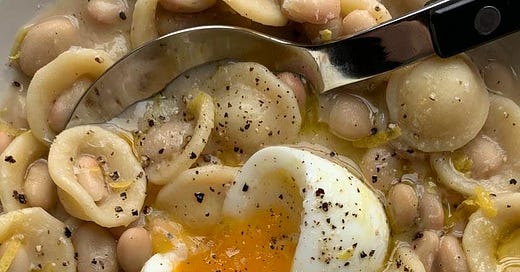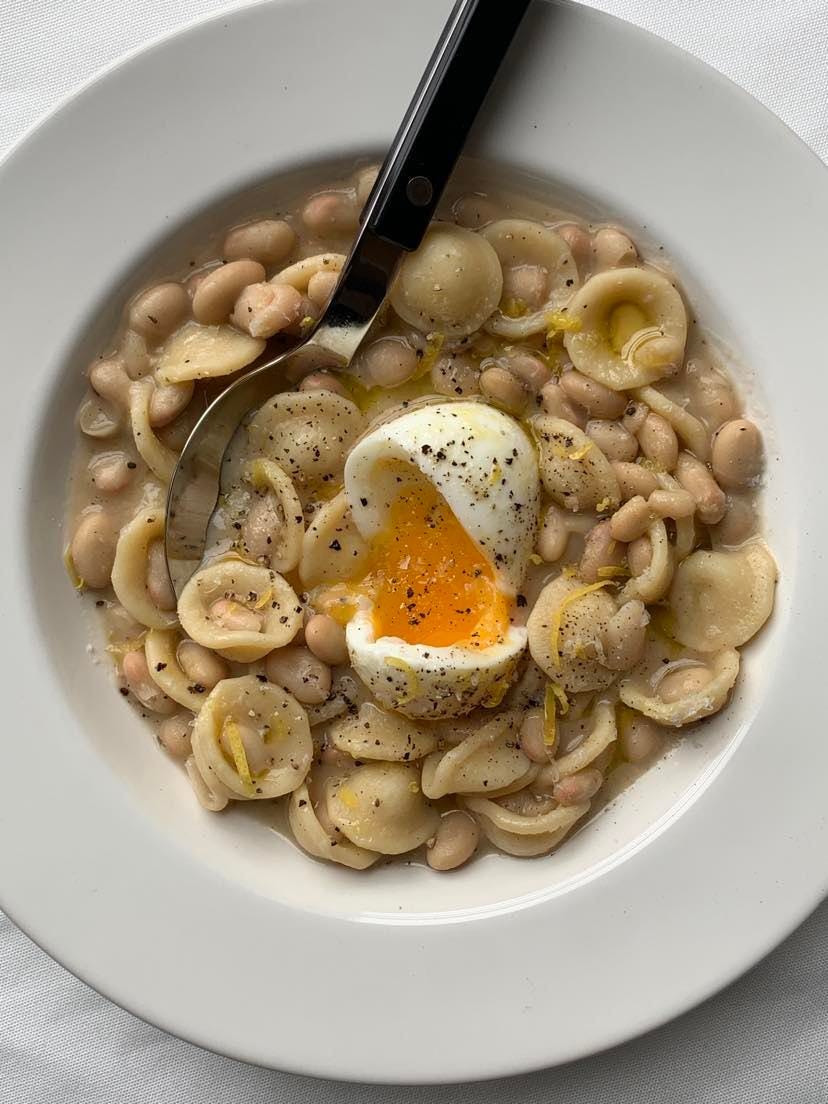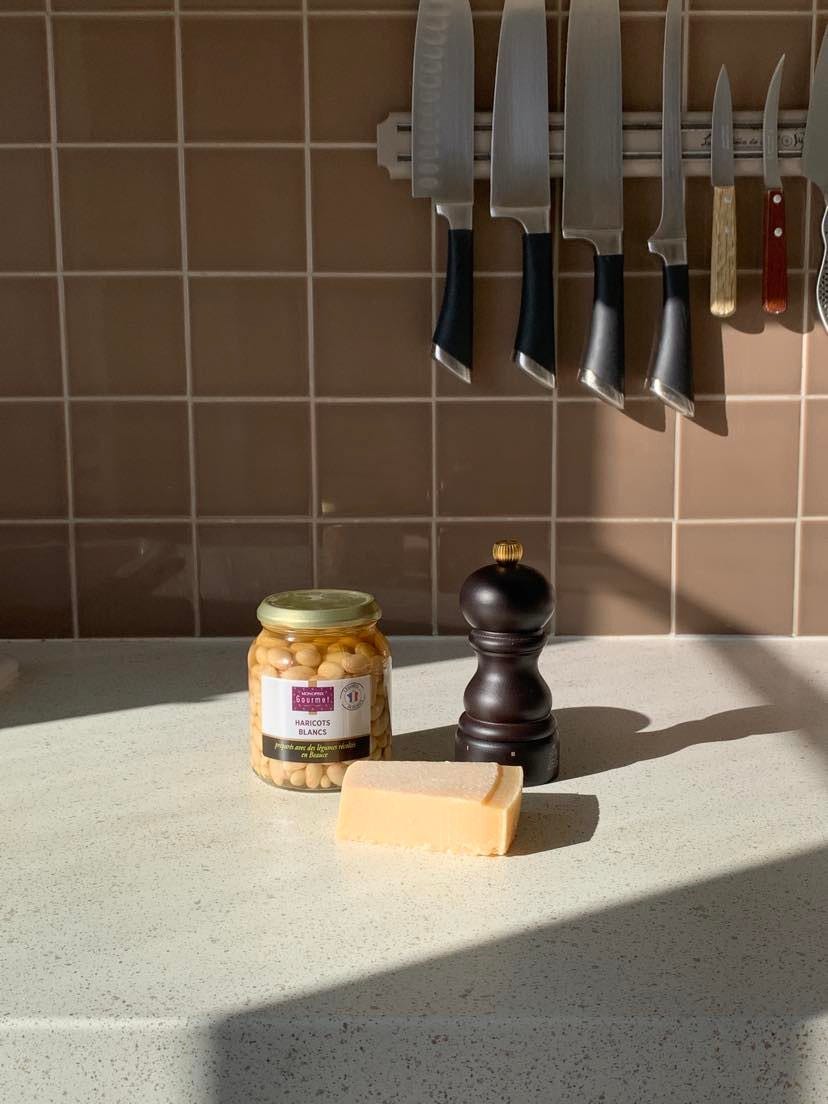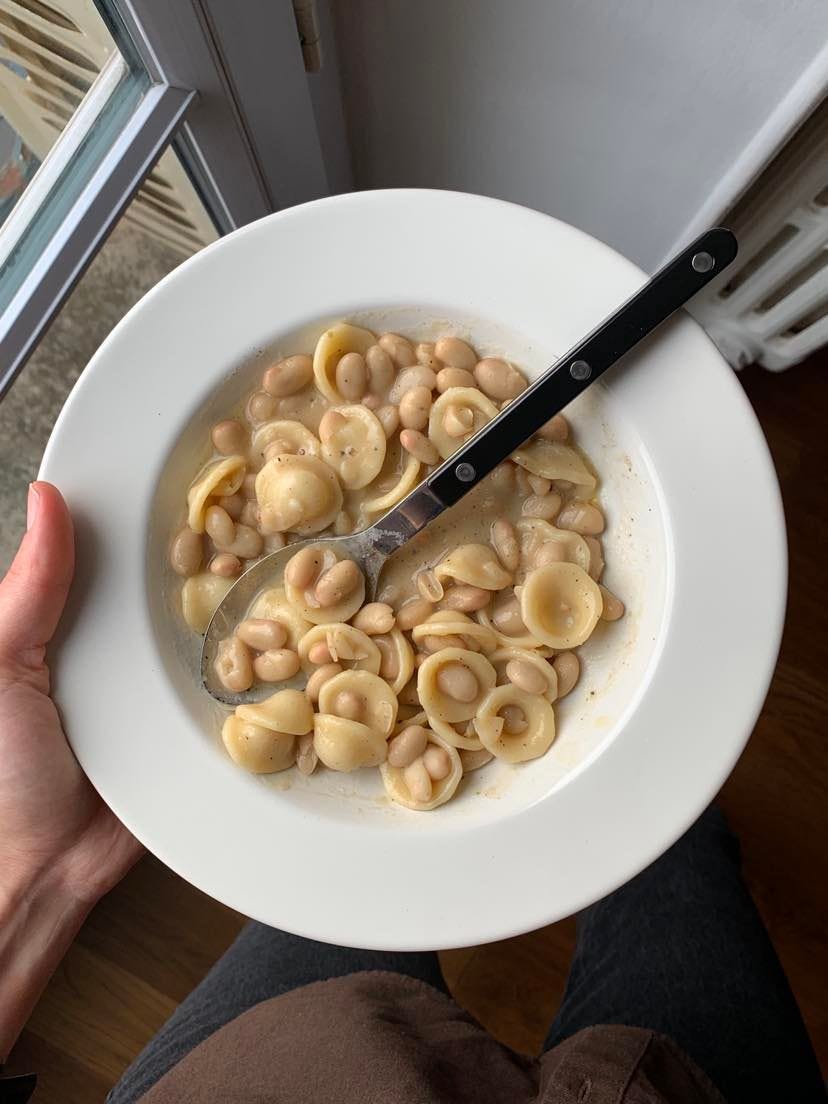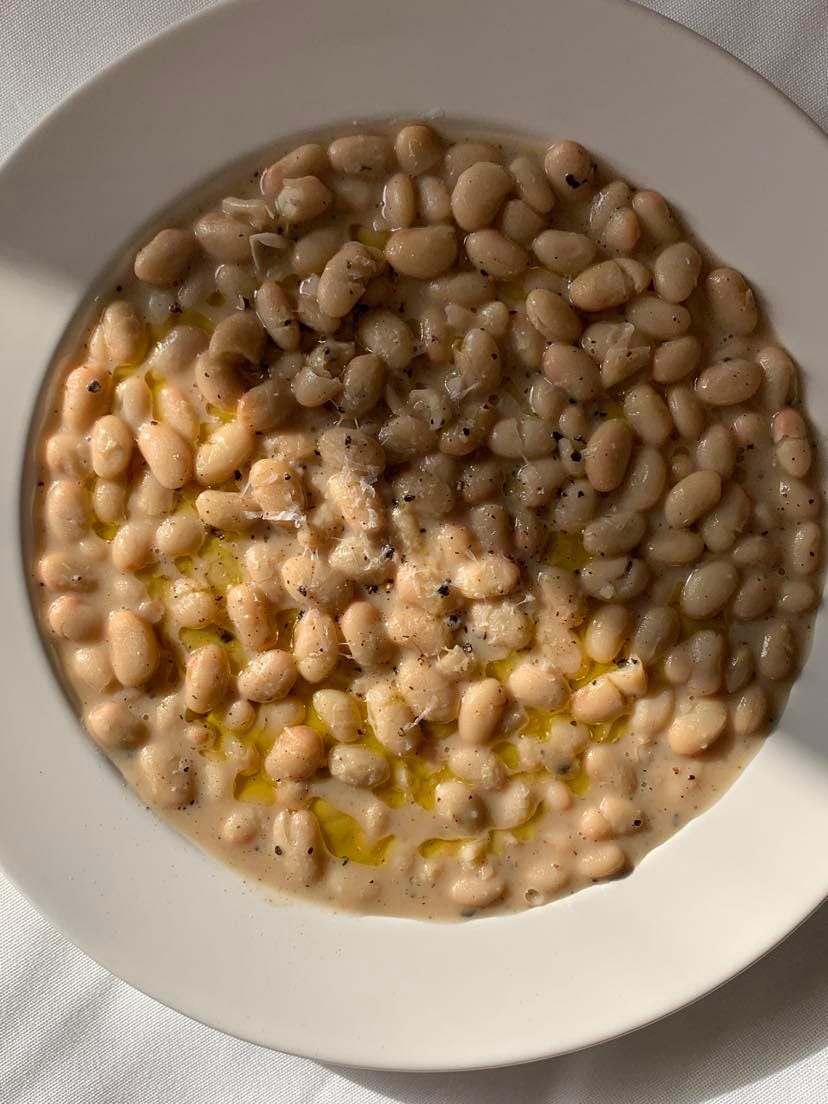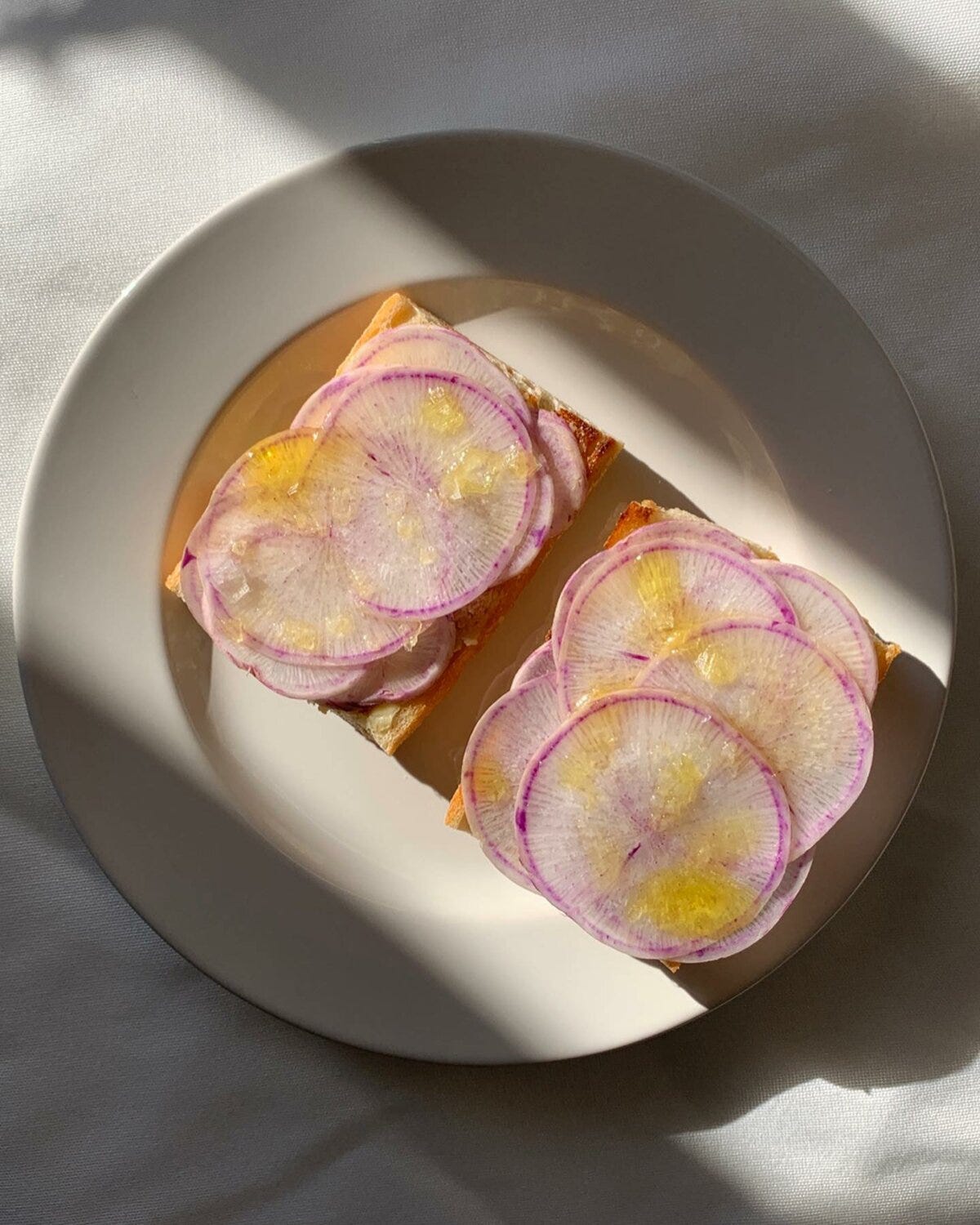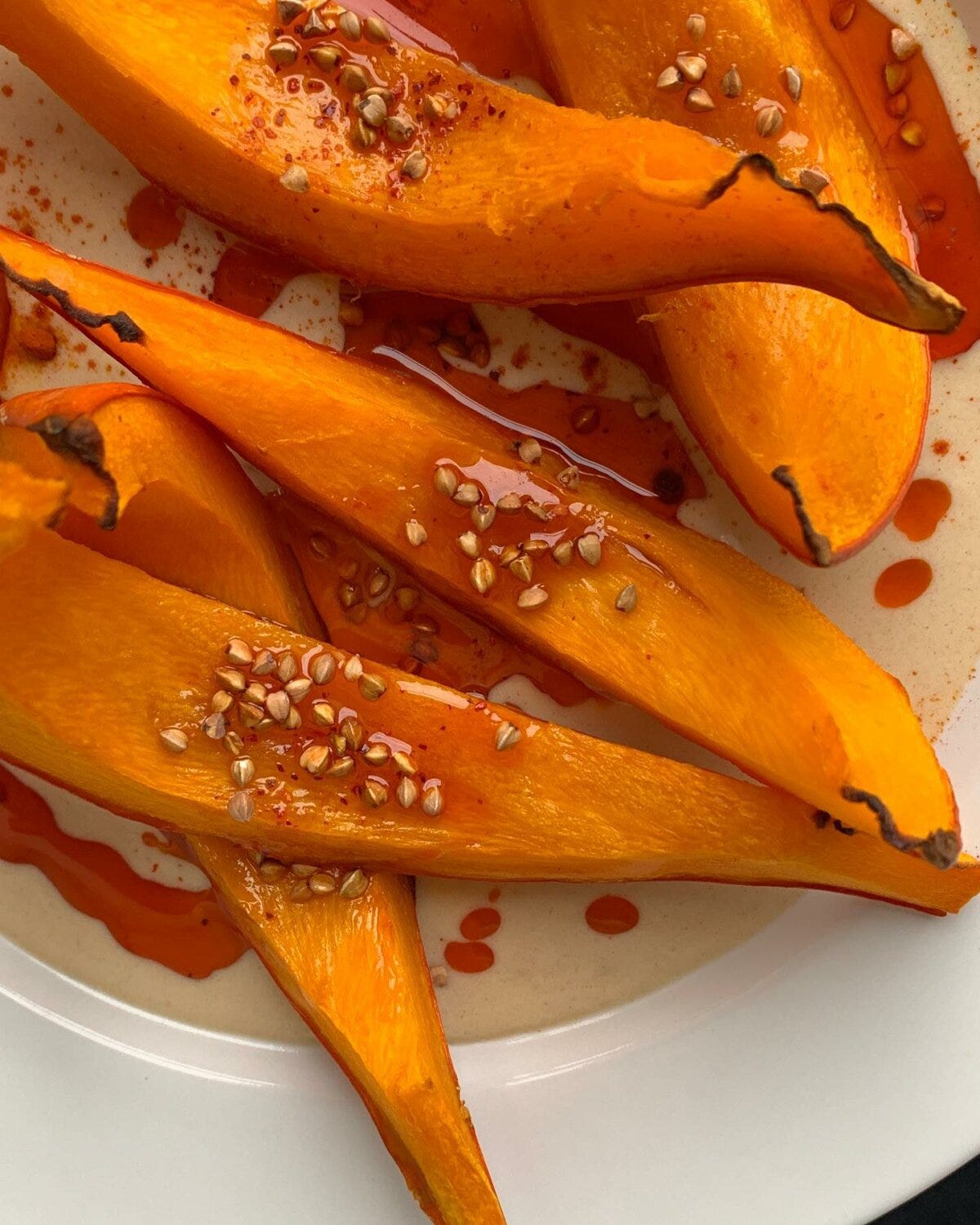Parmesan & Lemon White Bean Pasta (Three Ways)
cooking, fast and slow + finding beauty in the little things ✨
Spring is officially less than three weeks away.
If I were back in Norway or Canada, spring would feel like it was maybe coming around three weeks after that — here, in France, flowers have been popping up all over the place for three weeks already, it's gotten too hot to wear a tuque (which sucks for hiding bad hair days), and those two minutes of snow we got back in January simply never cared to stay on the ground and linger a little bit longer.
If it weren't for the seasonably short days, I think I would have believed it if someone told me that I had slipped into a deep coma back in autumn, skipped winter entirely, and was now waking up in what is very obviously April.
It's funny how sometimes we adapt quickly to things and other times it takes us ages. When it comes to seasons, I think I'm a slow learner.
That being said, I think experiencing the same season in different parts of the world gives you the perspective to notice and appreciate small things that you may have otherwise taken for granted. In Canada, it gets very cold. There's a lot of snow. The days are very short. These are things people will often complain about. But if it weren't for the cold, you wouldn't be able to experience the joy of skating outdoors (which makes this year's news about the Rideau Canal all the more devastating). If there weren't a lot of snow, you couldn't ski, or snowboard, or snowshoe or sled. If the days were long, you'd have no impetus for withdrawing into your home, making things cosy, and giving yourself much-needed annual rest. Things in Norway are similar. It gets quite cold there too (though generally not as cold as in Canada). There is also a lot of snow (and a lot of times there is more than in Canada). And the days border on insanity-inducing levels of short (the government really should consider handing out pamphlets to newcomers with tips on how to cope).
By comparison, in France, winter feels like a made-up season. Like something people tell each other exists, but really, it doesn't. Of course it gets cold — but not that much colder than you'd expect on a brisk fall day. Unless you're in the mountainous and picturesque ski-resorty parts of the country, there's rarely any snow. And yeah, the days are short, but are they really? (okay, admittedly, the days are shorter up here than they are for me back home — did you know that Canada's capital has roughly the same latitude as the middle of France? Toronto's basically as far south as Toulouse! — but they're still longer than they are in Norway). Overall, it feels more like a three-season land than a four-season one.
This is where the gratitude kicks in. In France I can think, “at least it's not as cold or dangerously icy as it is in Norway or Canada! I don't need as many layers or any gear to head outside!”. In Canada, I can think, “at least it's not as damp and moist as it is in France! My clothes can actually air dry and I don't feel the cold all the way into my bones!”. And so on and so forth. And, to be honest, I think most people would agree that fostering an attitude of appreciation where one might otherwise easily feel resentment or displeasure is a wonderful thing.
Speaking of which — I find myself switching my phone off more and more these days, intentionally creating little moments of “nothingness” throughout the week, refusing to fill silence with the usual podcast, radio or music on in the background. It's amazing how much there is to be found in spaces and places where one expects to find nothing at all.
The main benefit seems to be that I've started noticing things that I hadn't before, and that once I take notice of these things, I feel very thankful for noticing them in the first place.
The other day I caught myself actually enjoying doing the dishes.
Normally I put it off as long as I can muster. Once the inevitable task becomes avoidable no more, I rush through it as quickly and mindlessly as I can, like the despicable, unenviable chore that it is. Basically, I try to zone out and just get the job done. This time I zoned in.
Suddenly I was struck with an odd, warm, glowy feeling of... gratitude. To be quite honest, it was very bizarre (who feels grateful for doing the dishes?). I soon found myself having thoughts like, “How lucky am I to have functioning hands that allow me to carry out this necessary task!”, and “Isn't it nice that I care enough about my future self to get this chore done now so that I won't have to worry about it later?”, and even “What a great job of this I am doing! That's some quality dishwashing right there! Well done, you!”. By the time it came to rinsing suds off and drying everything by hand, I was cheerfully humming along.
This whole episode was so unlike my habitual dishwashing experience that I had to take a moment to, at the very least, try to understand what had triggered the change.
I think the short answer is that my mindset changed from “I have to do this” to “I get to do this”. And I think the reason it happened is because I let myself be present in the moment, and that, in turn, allowed me to meet a familiar task with fresh expectations.
I don't know exactly where I'm going with this (and I do apologise for droning on and on in this newsletter's intro), but I will say that there is something about doing something you know you ought to do, that will be good for you in some way, even if you don't feel like doing it, that is incredibly rewarding.
Cooking falls into this category, of course, and at the end of any season (again: spring officially arrives in less than three weeks!), it can be easy to fall into a cooking rut.
That's where looking at familiar ingredients with fresh eyes comes in. Whether you can't quite bring yourself to commit more than 15 minutes to the task, or whether it's a favourite activity in which you love to bask (ha! that rhymes!), taking the time and making the effort to cook for you and those you love is undoubtedly a worthwhile endeavour — one that can be made all the more pleasant if you embrace the moment, opening your mind to finding new little things to notice and appreciate along the way.
All that to say: do scroll on for some familiar ingredients presented in three perhaps-unfamiliar ways, adapted to three different time constraints, and then feel free to scroll down some more for some maybe-familiar meals that will hopefully serve as good inspiration for the weeks to come.
Here's wishing you a happy March, a healthy start of spring, and some wonderful times spent cooking ahead!
👋simone
p.s. I have loads lined up to share on Instagram in the coming weeks, so do keep yours eyes peeled 👀
parmesan & lemon white bean pasta
( three ways )
🍋
This isn't pasta e fagioli (pasta and beans). This isn't cacio e pepe (cheese and pepper [pasta]). And this isn't pasta al limone (lemon pasta) (yes, like the one in the previous newsletter...). But it is reminiscent of all three. Whether you've got 15 minutes to make a meal or a few hours until it's time to eat, you'll want to give this one a try.
•••
PARMESAN AND LEMON WHITE BEAN PASTA — THE SPEEDY WAY
serves 2
INGREDIENTS
• 205g cooked white beans, drained (and rinsed, if from a can)
• 120-150ml of vegetable stock, or well-seasoned, flavoursome bean broth if you have some though just-boiled water + a stock cube/powder works great!
• 65g dried orecchiette or another small pasta shape
• ¼ lemon, for its juice and zest
• butter
• olive oil
• ½ tsp black pepper, plus more for finishing freshly cracked, as always
• 12-16g parmesan freshly and finely grated
• coarse sea salt for seasoning the pasta water
• 2 eggs (optional) & flaky sea salt (for the eggs, so also optional)
note 1: use a bit less broth if you'd like the sauce to be a little creamier, and more if you'd like it to be little brothier; apply the reverse with the cheese
note 2: I chose orecchiette because the shape offers a perfect resting place for the beans to nestle into, as well as a nice pool for the sauce to collect — if you're using something else, try to keep the final dish in mind!
METHOD
note: steps 1 through 3, or even 1 through 5, can be carried out concurrently — the more you multitask, the faster the cook time! as always, read through the whole recipe before you begin
1. If adding the runny-yolked egg at the end of the dish, start by bringing a small pot of water to a boil. Once the water is boiling, reduce the heat from maximum to high, then lower in the eggs using a spoon. Set a timer for 5 minutes. When the timer goes off, remove the pot from the heat, pour out the hot water, and replace it with cold water from the tap to stop the cooking process. Peel the eggs, then return them to the pot along with more water. Set them aside.
2. Next, cook the pasta: grab a wide/shallow frying pan instead of a pot, and fill it with a minimal amount of cold water. This will leave us with a higher concentration of starch in the water by the time the pasta is cooked, and that's exactly what we want — the starch will help the cheese emulsify into a beautiful creamy sauce, and it will also make it easier for the cheese to tolerate heat without splitting.
Bring the water to a boil, season it slightly-less-abundantly-than-usual with salt (remember: we're using less cooking water than usual here, and our cheese is already quite salty), and add in the pasta. Cook for two minutes less than indicated on the package instructions. Once the timer goes off, pour out the pasta water into a bowl and reserve it for later. Then, add cold water back to the pan along with the pasta to cool it down and stop the cooking process. Set the bowl of hot pasta water and the pan of cooled, nearly-cooked pasta aside.
3. Place a medium-small pot on medium-low heat, and crack in ½ teaspoon's worth of black pepper, straight from the pepper mill (note: this is more likely to look like a whole teaspoon if you're using an actual teaspoon, and not a measuring spoon like I did to provide the measurement above). Toast the pepper, swirling the pot occasionally, until you can smell it. It might feel like nothing is happening at first, but very quickly your pepper can start to smoke and burn, so keep an eye (and a nose) on it.
4. Add 120-150ml of bean broth or vegetable stock to the black pepper, as well as approx. 30-45ml of pasta water and 205g cooked white beans. Add in a knob of butter and a tiny splash of olive oil, then turn the heat up a little to bring everything to a simmer.
5. Let the peppery broth bubble away until it has thickened and reduced somewhat, starting to look like cream over the beans. Using a spider or slotted spoon (or even your fingers, I've done it), transfer the very al dente pasta to the pot along with the beans to finish cooking. Swirl the pot every now and then to keep things moving.
6. Zest the quarter lemon and reserve the zest for the garnish. Then squeeze the lemon juice into the pot with the beans and stir it through.
At this point, if you are serving the dish with the soft-boiled eggs and they have been sitting at room temperature for a short while, you may want to reheat them in a simmering pot of water for 30-60 seconds (though to be honest, I couldn't be bothered to do this).
7. Remove the pot of pasta and beans from the stove and incrementally stir through 12-16g of grated Parmesan into the beans and pasta, letting it melt and emulsify into a creamy sauce as you go. At this point you can taste the pasta and beans and adjust for seasoning by adding a little more pepper, cheese, or even salt. You can also adjust the amount of broth if you've got some leftover.
8. Very quickly, white still hot, transfer the beans and pasta to two plates. If using the eggs: make a small nest in the middle of each plate using the back of a spoon, then drop in a soft-boiled egg into each. Season only the eggs with flaky sea salt. Finish each dish with more freshly cracked black pepper, freshly grated Parmesan cheese, the lemon zest, and a drizzle of extra virgin olive oil. All that's left to do now is enjoy.
•••
This next version is all about slowly building up flavour in the broth before proceeding to the speedy cooking of the pasta and warming of the beans. You could also cook your own beans from scratch while you're at it, though I admit I had perfectly good jarred beans on hand so didn't feel the need to cook any.
PARMESAN AND LEMON WHITE BEAN PASTA — THE SLOWER WAY
serves 2
INGREDIENTS
for the parmesan broth
• 1 small onion, unpeeled
• 3 fat (or 5 small) cloves of garlic, unpeeled
• 1 small bunch parsley stalks
• 2-3 stalks thyme
• 1 small branch rosemary
• 1 large (or 2 small) bay leaves
• 1 tsp whole black peppercorns
• white wine
• 1 Parmesan rind
• extra virgin olive oil
• sea salt (optional, for adjusting the seasoning if necessary)
for the pasta and beans
see the speedy version above!
note: parmesan broth typically has many parmesan rinds in it, but that just seems impractical for the average cook (and for me!) so this broth recipe only uses one — the parmesan flavour won't be as intense, but I promise it will be there nonetheless! also, you won't have to spend months and/or a small fortune collecting rinds to make it :)
METHOD
for the parmesan broth
1. Let's make a parm broth! Roughly quarter your onion and halve your garlic cloves, keeping the skins on. Add them to a medium-sized pot along with a good glug of olive oil, bring the heat to medium, and let them sizzle until they get a bit of colour on them.
2. Add the parsley stalks, thyme, rosemary, bay leaves and peppercorns, and stir them through, leaving to sizzle a little longer, stirring occasionally.
3. Once the garlic is deep brown (but not burned), deglaze the pot with a good splash of white wine. Let the wine reduce and the alcohol evaporate before adding in the Parmesan rind and covering everything with around 1.4L of water.
4. Bring the water to a boil, then reduce the heat to low and leave to simmer gently, stirring occasionally so the rind doesn't stick to the bottom of the pot, until the broth is flavourful and has reduced a fair bit, at least two hours (ideally three, and up to four). Taste and adjust seasoning if necessary.
5. Strain the broth. It's ready to use!
for the pasta and beans
see speedy version above!
tip: if you'd like to make the broth but only have an extra thirty minutes instead of two to four hours, you can pop in a stock cube, reduce the water to ∼900mL instead of 1.4L, and turn the temperature to medium instead of low to simmer the broth a little bit faster. It'll help to amp up the flavour in a short time and honestly makes for a decent shortcut!
•••
This last version is more of a twist. Basically, the bean and pasta dish becomes a bean dish and, in the process, perhaps also makes the transition from meal to side. Or not. You decide.
PARMESAN AND LEMON WHITE BEANS (NO PASTA) — THE SPEEDIEST WAY
serves 2
INGREDIENTS
• 205g cooked white beans, drained (and rinsed, if from a can)
• 135-165ml of vegetable stock, or well-seasoned, flavoursome bean broth if you have some though just-boiled water + a stock cube/powder works great!
• ¼ lemon, for its juice and zest
• butter
• olive oil
• ½ tsp black pepper, plus more for finishing freshly cracked, as always
• 12-16g parmesan freshly and finely grated
note: use less broth if you'd like the sauce to be a little creamier, and more if you'd like it to be little brothier; apply the reverse with the cheese
METHOD
1. Place a small saucepan on medium-low heat, and crack in a half teaspoon's worth of black pepper, straight from the pepper mill (note: this is more likely to look like a whole teaspoon if you're using an actual teaspoon, and not a measuring spoon, like I did, to provide the measurement above). Toast the pepper, swirling the pot occasionally, until you can smell it. It might feel like nothing is happening at first, but very quickly your pepper can start to smoke and burn, so keep an eye (and a nose) on it.
2. Add 135-165ml of bean broth or vegetable stock to the black pepper and 205g cooked white beans. Add in a good knob of butter and a tiny splash of olive oil. Turn the heat up a little to bring everything to a simmer.
3. Let the peppery broth simmer until it has thickened and reduced somewhat, looking like cream over the beans (you also want to make sure that the beans are warm all the way through). Swirl the pot every now and then to keep things moving.
4. Zest the quarter lemon and reserve the zest for the garnish. Then squeeze the lemon juice into the pot with the beans and stir it through.
5. Remove the pot from the stove and incrementally stir through 12-16g of grated Parmesan into the beans, letting it melt and emulsify into a creamy sauce as you go. At this point you can taste the sauce and beans and adjust for seasoning by adding a little more pepper, cheese, or even salt.
6. Very quickly, white still hot, transfer the beans to two plates. Finish each dish with more freshly cracked black pepper, freshly grated Parmesan cheese, the reserved lemon zest, and a drizzle of extra virgin olive oil.
Grab a spoon and enjoy hot (perhaps even paired with a hunk of hot crusty bread to help you mop up your plate).
If you're feeling adventurous and have some time on your hands, I have a hunch that putting the Parmesan broth ingredients into a cheesecloth or small sieve and cooking your dried white beans from scratch at the same time, all in one pot, might deliver the maximum flavour-texture experience...
I just haven't tried it yet!
in case you missed it
some ideas from insta
✨
Radishes on buttered, toasted bread. I have to admit I wasn't convinced until I tried it myself. It sounds simplistic, dated and dull. But oh my heavens it tastes amazing!!! Now I understand why so many people love it, and I am on a unwavering mission to get everybody I know (and don't know) to try it.
Roasted red kuri squash, soft and tender through the flesh, yet crisp and caramelised around the edges. Creamy, saucy tahini. Spiced (and spicy) harissa oil. Toasted buckwheat, crunchy. The eater, happy.
Citrus season is winding down, so now's the time to make up for lost citrus and seize the salad. Throw in some beets and radicchio and you've got yourself a gorgeous end-of-season citrus salad, ready to carry you brightly into spring.
That's all from me this month! Thank you for being here, and see you next time 💛
This was a Substack edit of an archived newsletter. To read the newsletter in its original format, click here.


